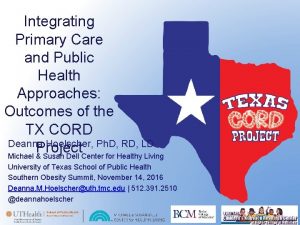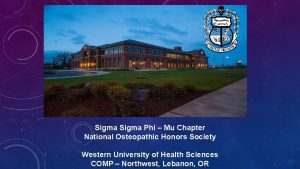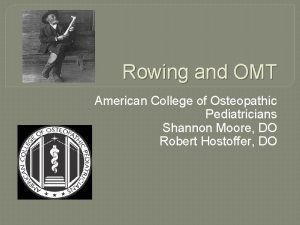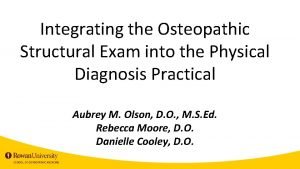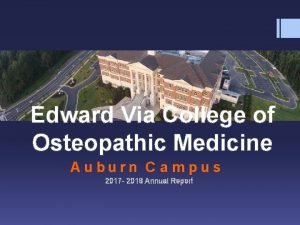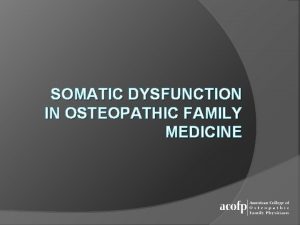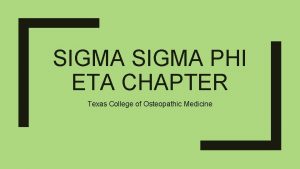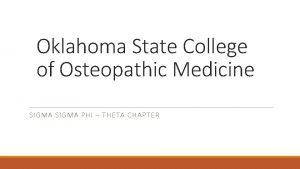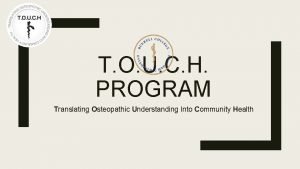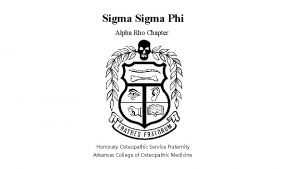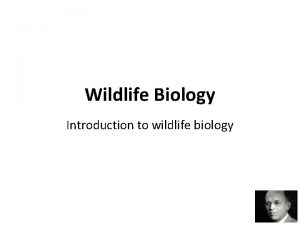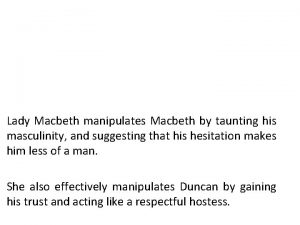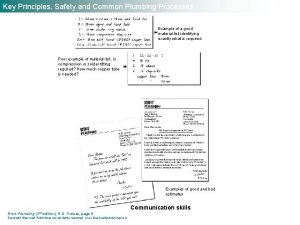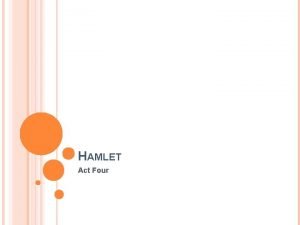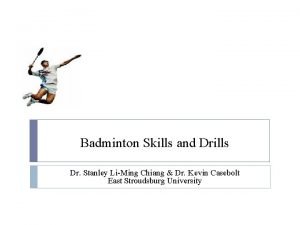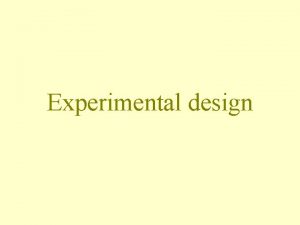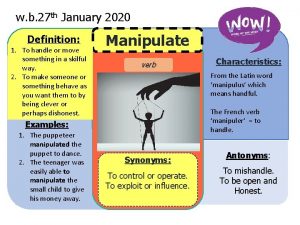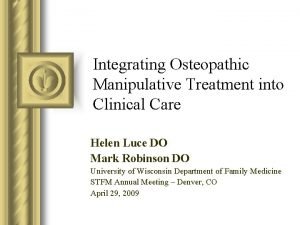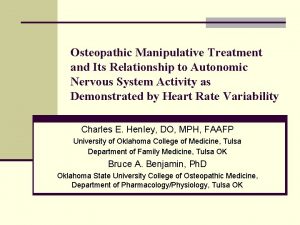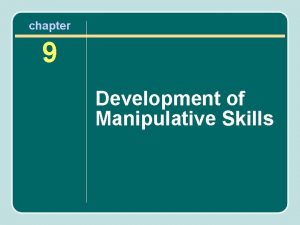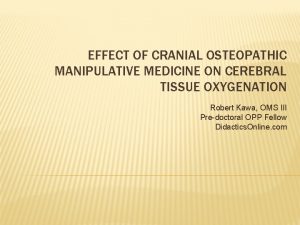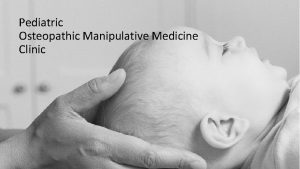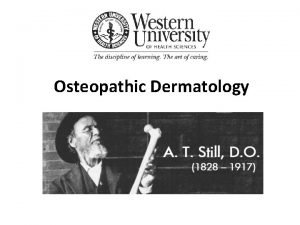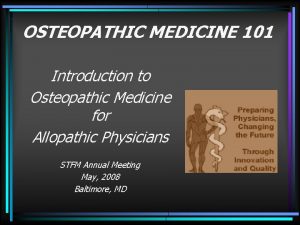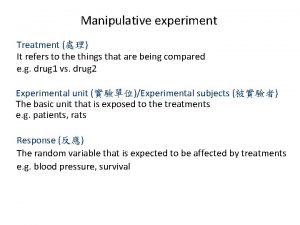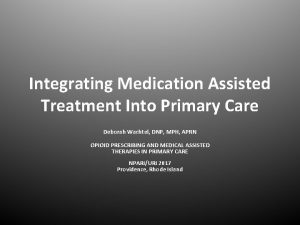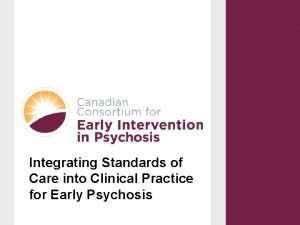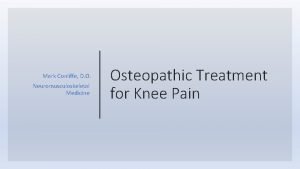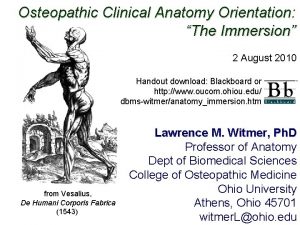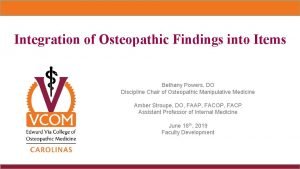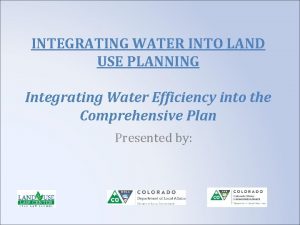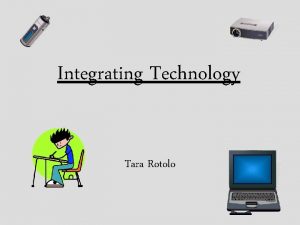Integrating Osteopathic Manipulative Treatment into Clinical Care Helen


























- Slides: 26

Integrating Osteopathic Manipulative Treatment into Clinical Care Helen Luce DO Marguerite Elliott DO, MS Mark Robinson DO University of Wisconsin Department of Family Medicine May 3, 2008

Welcome & Introductions n Presenters n n n Helen Luce DO Marguerite Elliott DO, MS Mark Robinson DO n Purpose of seminar n Overview of osteopathic philosophy, the use of OMT in specific clinical scenarios, and guidelines for the allopathic precepting physician.

Objectives n Describe 3 clinical situations in which OMT can be performed to augment other medical therapy and improve patients’ health. n Participate in OMT through observation or performance of 2 specific treatments. n Discuss precepting methods for allopathic physicians who supervise osteopathic residents performing OMT.

Overview n Osteopathic medicine n Osteopathic philosophy n OMT (Osteopathic Manipulative Treatment) n Overview of some common techniques

Definition n Osteopathic Medicine n A system of diagnosis and treatment that recognizes the role of the musculoskeletal system in the healthy functioning of the human body. -From the AMA Encyclopedia of Medicine

Osteopathic Philosophy n Four basic principles n n Body functions as a unit – body, mind, spirit Structure and function are interrelated Body is capable of self-regulation, self-healing, and health maintenance Rational treatment is based on understanding these principles

Somatic Dysfunction n Impaired or altered function of related components of somatic system (body framework) n n Skeletal and myofascial structures Related vascular, lymphatic, & neural elements

Palpatory Diagnosis n T: Tissue texture abnormalities n A: Asymmetry n R: Restriction of motion n T: Tenderness

Barrier Concepts n Anatomic Barrier n Physiologic Barrier n Restrictive Barrier Anatomic Physiologic Barrier Restrictive Barrier Physiologic Barrier Anatomic Barrier

Direct and Indirect Techniques n Direct Technique that engages the most restrictive barrier n Indirect n Technique that engages the least restrictive barrier n

Forces Applied in OMT n Extrinsic Supplied by physician n Intrinsic n Supplied by patient n

OMT n Includes many different techniques n Requires additional training (200 -600 hrs during med school) n Requires ongoing practice and continuing education

Safety of OMT n Low rate of complications (1 in 1 million) n Careful patient and modality selection n Most common complications n n Vertebrovascular accidents Cauda Equina syndrome n Modality most associated with complications is HVLA

Contraindications n Case-by-case basis n Fracture, dislocation, tumor, infection, and osteomyelitis are contraindications for OMT directly over that site n Conditions to consider carefully: n Down Syndrome, RA, pregnancy, strains & sprains, acute herniated disc, acute inflammatory situations, anatomic instability, hypermobility, joint prosthesis, and severe manifestations of visceral disorders

Common Techniques n HVLA n Visceral n Muscle Energy n Myofascial Release n Soft Tissue n Cranial n Counterstrain n Techniques of Still n Facilitated Positional n Balanced Ligamentous Release n Lymphatic Tension & Ligamentous Articular Strain n Articulatory

Soft Tissue Techniques n Direct technique n “Involves lateral stretching, linear stretching, deep pressure, traction, and/or separation of muscle origin and insertion while monitoring tissue response and motion changes by palpation” n Indications n ↓muscle spasm; stretch and ↑elasticity; improve circulation; ↑ venous and lymphatic drainage; promote patient relaxation n Absolute contraindications: none

Myofascial Release Techniques n Direct, indirect, or combination of both n “Designed to stretch and reflexly release patterned soft tissue and joint-related restrictions” n Indications n ↓ muscle and fascial tension; stretch and ↑ elasticity in tight tissues; improve circulation to specific region; ↑ venous and lymphatic drainage n Absolute contraindications: none

Muscle Energy Techniques n Direct technique n “system of diagnosis and treatment in which the patient voluntarily moves the body as specifically directed by the physician; from a precisely controlled position, against a defined resistance by the physician” n Indications n n 1º = Somatic dysfunction of myofascial or articular origin 2º = Improve circulation, balance neuromuscular relationships, and ↑ tone in hypotonic/weak muscles n Absolute contraindications n n Fracture, dislocation, or joint instability at treatment site Patient unable to understand instructions or uncooperative

HVLA n Direct technique n “Uses high-velocity/low-amplitude forces; also called mobilization with impulse treatment” n Indications n Somatic dysfunction of articular origin n Absolute contraindications n Joint instability; severe osteoporosis; bony metastasis, osteomyelitis, other infection, or joint replacement in the treatment area; osteoarthritic joint with ankylosis; severe herniated disc with radiculopathy; congenital anomalies; Down syndrome (esp. c-spine); RA of c-spine; achondroplastic dwarfism (c-spine)

Balanced Ligamentous & Ligamentous Articular Strain Techniques n Indirect technique n Indications n Somatic dysfunctions of articular or myofascial basis; areas of lymphatic congestion or local edema n Absolute contraindications: none

Visceral Techniques n Direct, indirect, or combined n “system of diagnosis and treatment directed to the viscera to improve physiologic function; typically the viscera are moved toward their fascial attachments to a point of fascial balance” n Indications n n Multiple, depending on specific organ dysfunctions Cardiac, pulmonary, GI, GU, gyn, etc. n Absolute contraindications: none

Lymphatic Techniques n Technique classification n Techniques removing restrictions to lymphatic flow vs. those promoting lymphatic flow n Indications n Lymphatic congestion (postsurgical edema), mild to moderate CHF, URI/LRI, other infections, asthma, COPD, pain due to lymphatic congestion & swelling n Absolute contraindications n Fracture, dislocation, or osteoporosis; acute hepatitis; malignancy; organ friability (inf. Mono); acute indurated lymph node

Interactive Clinical Scenarios (small groups) n Headaches n Otitis media n Post-op ileus n Constipation n Pneumonia n Back pain in pregnancy n GERD n Edema in pregnancy n Asthma n Dysmenorrhea n Sinusitis n Carpal Tunnel n Hiccups Syndrome n Others…

Summary n Osteopathic Medicine and Osteopathic Philosophy n Review of common OMT techniques n Examples of using OMT in specific clinical situations n Guidelines for allopathic preceptors

Resources n Nicholas, A and Nicholas, E. Atlas of Osteopathic Techniques. Philadelphia: Lippincott Williams & Wilkins, 2008. n Ward, R (ed). Foundations for Osteopathic Medicine. Philadelphia: Lippincott Williams & Wilkins, 2003. n Greenman, P. Principles of Manual Medicine. Philadelphia: Lippincott Williams & Wilkins, 2003. n Nelson, K and Glonek, T (ed). Somatic Dysfunction in Osteopathic Family Medicine. Philadelphia: Lippincott Williams & Wilkins, 2006.

Questions?
 Helen midtown computer solutions helen speaking
Helen midtown computer solutions helen speaking Teaj
Teaj Hip fracture clinical care standard
Hip fracture clinical care standard Direct quote
Direct quote Paragraph
Paragraph Integrating public health and primary care
Integrating public health and primary care Health care levels primary secondary tertiary
Health care levels primary secondary tertiary Psi sigma alpha osteopathic honor society
Psi sigma alpha osteopathic honor society Rib raising omt
Rib raising omt Osteopathic physical exam documentation
Osteopathic physical exam documentation Edward via college of osteopathic medicine auburn
Edward via college of osteopathic medicine auburn Urt
Urt Texas college of osteopathic medicine
Texas college of osteopathic medicine Oklahoma state college of osteopathic medicine
Oklahoma state college of osteopathic medicine Touch program osteopathic
Touch program osteopathic Arcom mission statement
Arcom mission statement Manipulative management wildlife
Manipulative management wildlife What is communicating in science process skills
What is communicating in science process skills Lady macbeth manipulation
Lady macbeth manipulation Common plumbing processes
Common plumbing processes Quotes of claudius being manipulative
Quotes of claudius being manipulative Forward forehand badminton
Forward forehand badminton Badminton footwork diagram
Badminton footwork diagram Integer chips virtual manipulative
Integer chips virtual manipulative Indirect measurement instruments
Indirect measurement instruments Experiment vs study
Experiment vs study What is manipulation
What is manipulation





